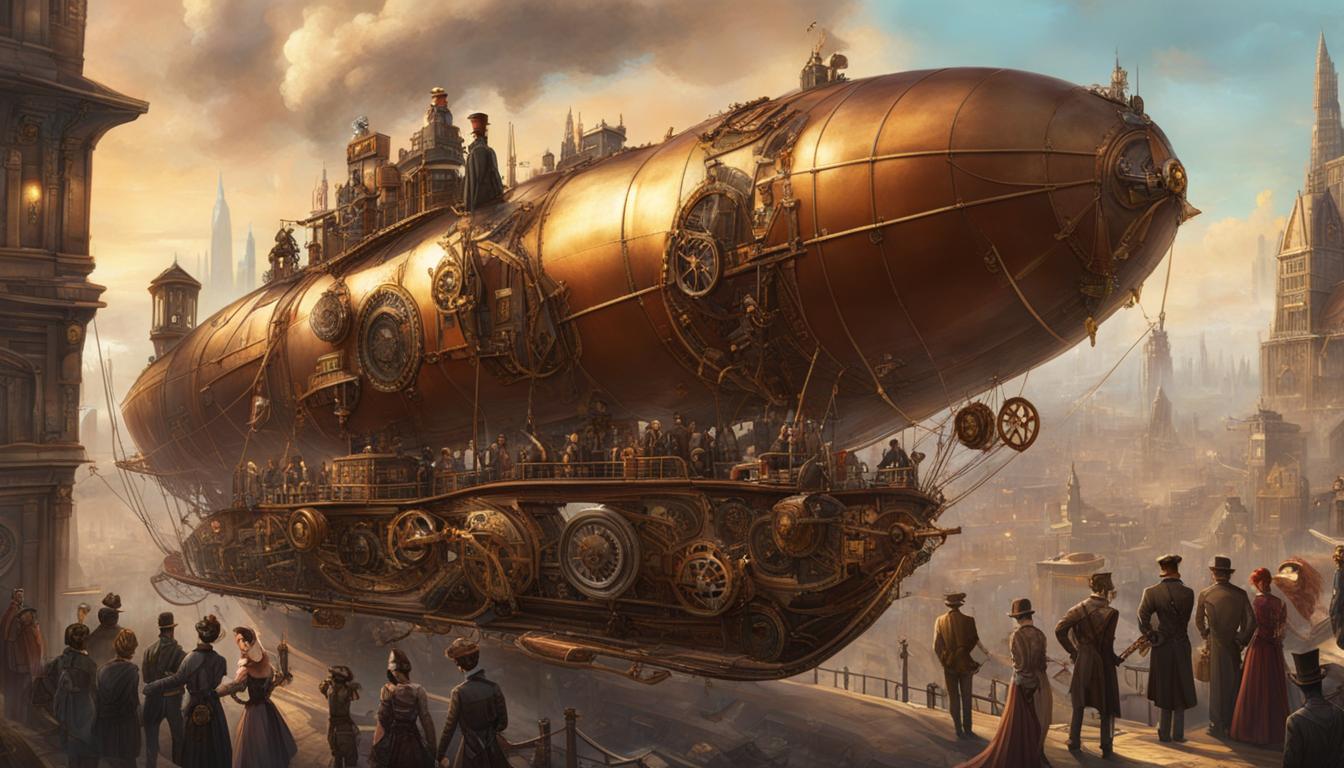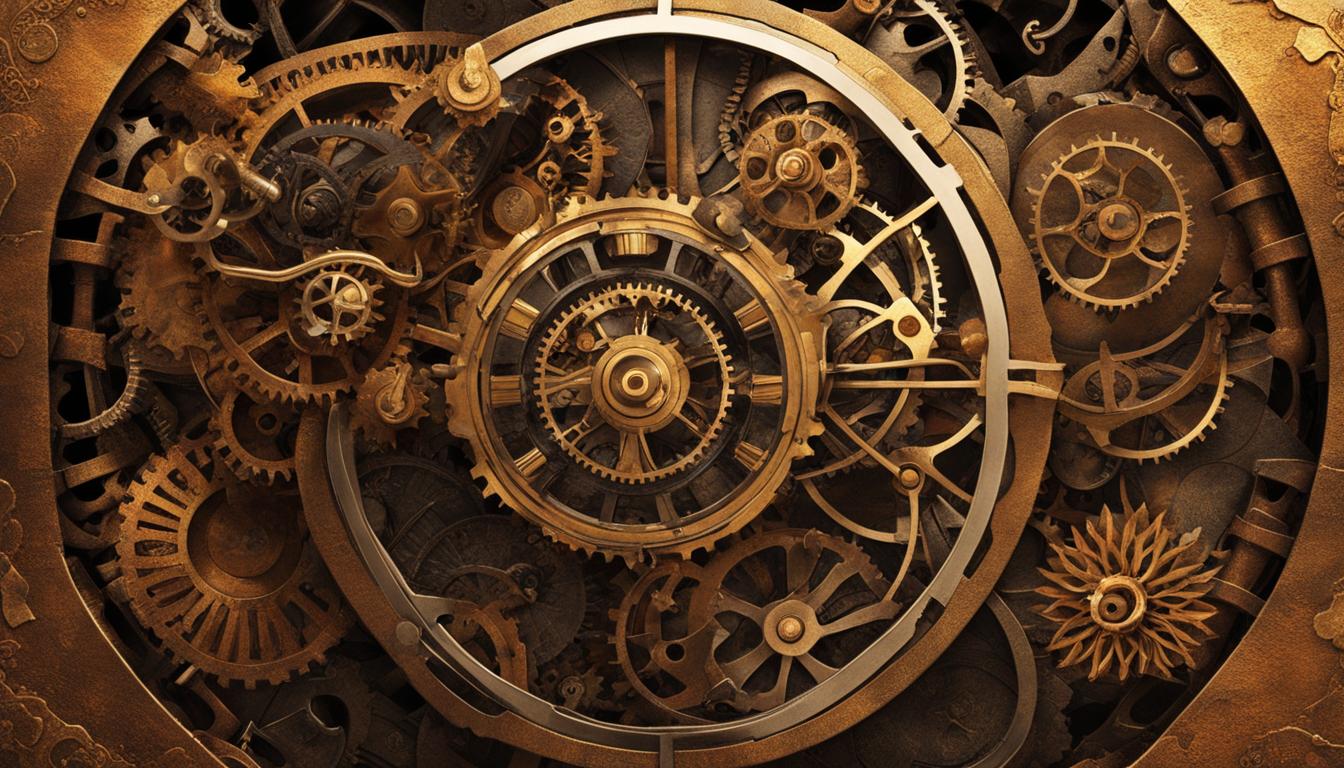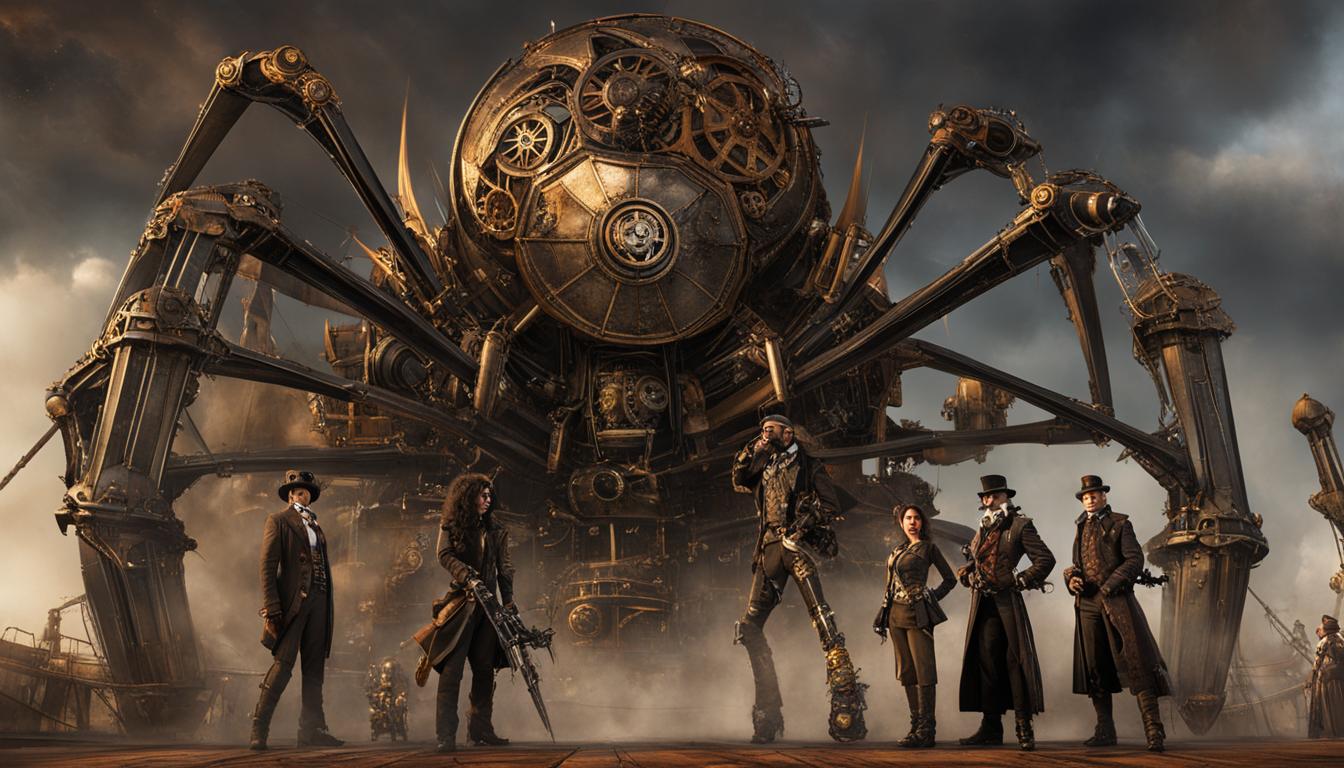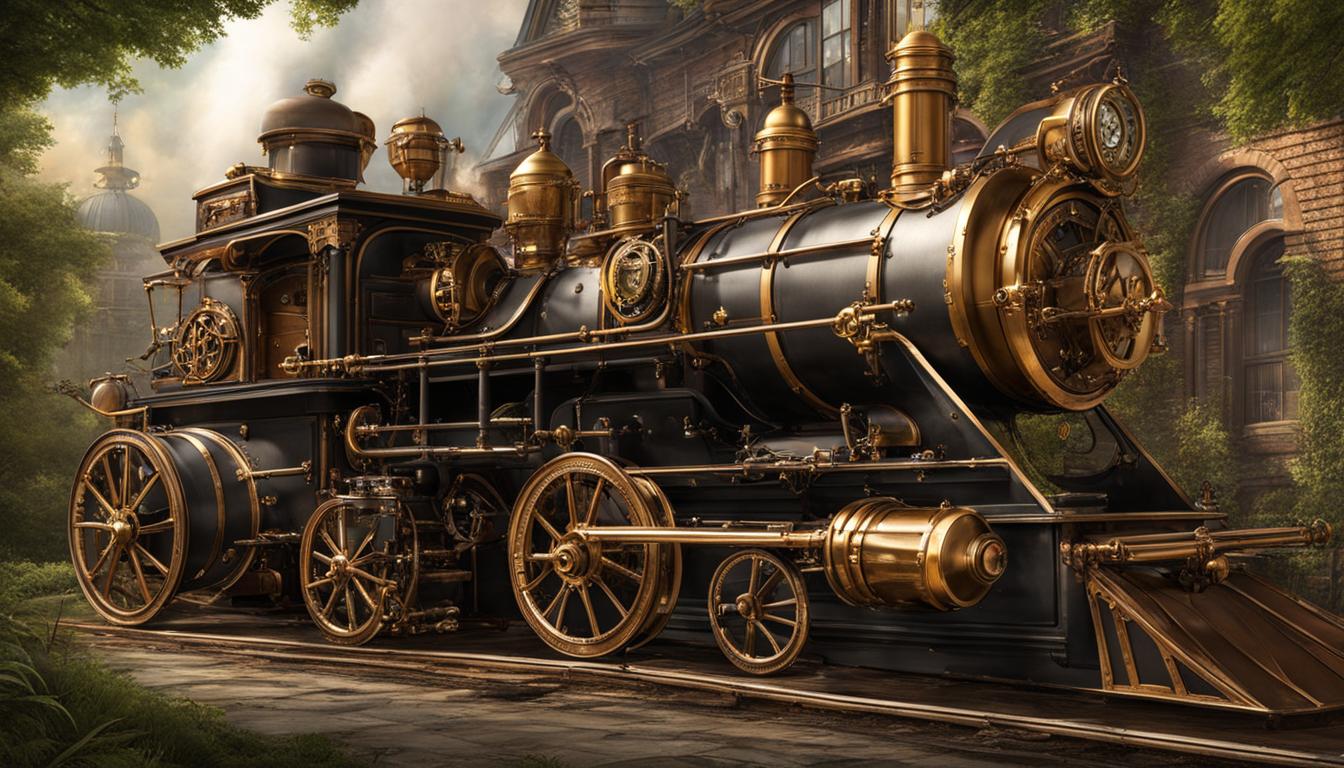Welcome to the fascinating world where steam-powered machinery meets alternative history and postmodern philosophy. In this article, we will explore the captivating relationship between steampunk and postmodernism, delving into the influence of postmodernism on steampunk culture and examining steampunk as a postmodern genre.
Steampunk, a subgenre of science fiction, takes inspiration from the industrial wonders of the 19th century. It combines retrofuturistic technology with elements of fantasy, horror, and alternate history, creating a unique hybrid genre that transports us to alternative pasts and futures. Steampunk works not only entertain but also address real-world social issues, making them thought-provoking and relevant.
Postmodernism, on the other hand, challenges traditional notions of truth, reality, and history. It embraces ambiguity and multiple perspectives, blurring the boundaries between past and present. Steampunk, as a genre, has absorbed these postmodern ideas, incorporating them into its narratives and aesthetics.
Key Takeaways:
- The relationship between steampunk and postmodernism is a complex interplay of aesthetics, themes, and philosophy.
- Steampunk incorporates retrofuturistic technology and alternative history, reflecting on the past while imagining alternative futures.
- Postmodernism’s influence can be seen in steampunk culture through intertextuality, social commentary, and the deconstruction of traditional narratives.
- Steampunk challenges linear storytelling and embraces ambiguity, blurring the boundaries between genres and realities.
- Steampunk’s unique aesthetic and cultural impact have influenced various aspects of popular culture, including fashion, art, design, and music.
The Influence of Postmodernism in Steampunk Culture
Postmodernism has left an indelible mark on the world of steampunk, influencing its culture and narratives in profound ways. One of the key elements that postmodernism brings to steampunk is intertextuality, weaving together references to other works of literature, art, and pop culture. These intertextual connections create a rich tapestry of ideas and meanings, inviting readers and viewers to engage in a game of intellectual hide-and-seek. As they unravel these hidden references, they enter into a dialogue with the creators, forming a deeper connection with the steampunk world.
But steampunk is not limited to mere intertextuality. It also serves as a commentary on contemporary society, reflecting on issues such as social class, technological advancements, and the impact of industrialization. By juxtaposing the Victorian era with futuristic steam-powered technology, steampunk provides a lens through which we can examine our own modern world. It challenges us to question the progress we have made and the consequences that come with it.
“Steampunk is a genre that allows us to explore the intricacies of our own society by peering through the looking glass of the past. It is a reflection on the present, the future, and the paths we have taken to get here.”
Furthermore, steampunk narratives often deconstruct history, challenging traditional notions and exploring alternate perspectives. It questions the idea of a singular, objective truth by presenting alternative versions of the past. This deconstruction enables us to reexamine our own historical narratives and consider the possibility of multiple realities or interpretations. Steampunk embraces postmodern themes, blurring the boundaries between past, present, and future, and inviting us to think critically about the constructions of our own reality.
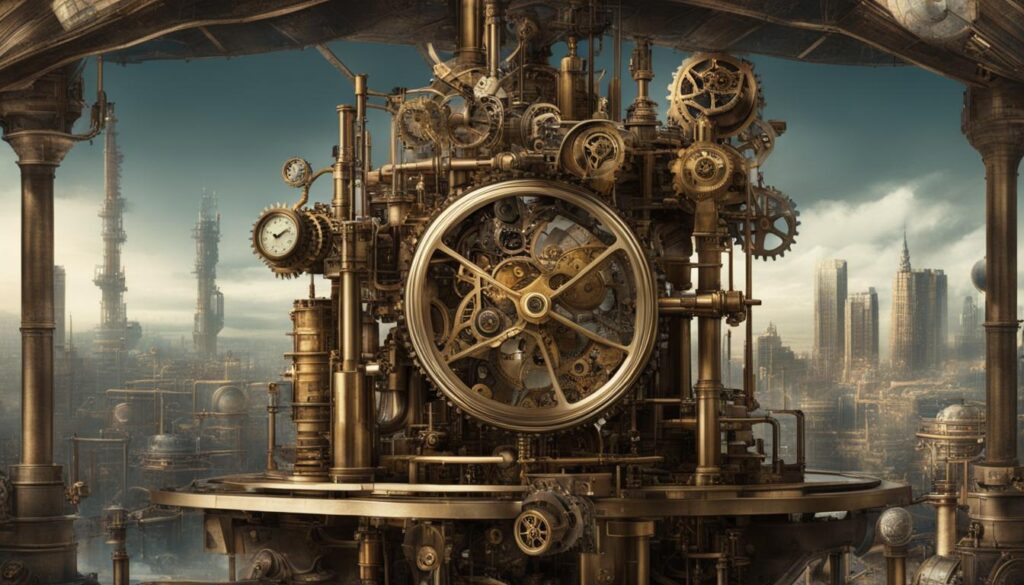
| Postmodern Themes in Steampunk Stories | Examples |
|---|---|
| Blurring of boundaries between past, present, and future | “The Difference Engine” by William Gibson and Bruce Sterling |
| Deconstruction of history | “Perdido Street Station” by China Miéville |
| Intertextuality | “The League of Extraordinary Gentlemen” by Alan Moore and Kevin O’Neill |
The influence of postmodernism in steampunk culture is undeniable. It adds depth, complexity, and intellectual intrigue to the genre, making it a captivating and thought-provoking experience for enthusiasts and newcomers alike.
Steampunk as a Postmodern Genre
Steampunk can be considered a postmodern genre that reflects on both the past and the present. It challenges linear narratives and traditional notions of history by presenting an alternative version of the past. Steampunk literature often incorporates meta-narratives, exploring the ways in which stories shape our understanding of reality.
Steampunk takes a unique approach to postmodern philosophy, questioning established beliefs and embracing ambiguity. It blurs boundaries between genres, combining elements of science fiction, fantasy, and historical fiction to create unconventional and thought-provoking tales. The genre’s ability to seamlessly blend past and future, reality and fantasy, makes it an intriguing and captivating form of postmodern storytelling.
Steampunk literature provides a platform for authors to challenge the status quo, question historical narratives, and explore the possibilities of alternate realities. It encourages readers to question their own beliefs and concepts of truth by presenting them with a world where the impossible becomes possible.
Steampunk narratives often feature complex characters who navigate a world that blends Victorian England with fantastical elements. They uncover hidden truths, challenge societal norms, and ultimately invite readers to reflect on their own place in the world. The genre’s reflection on the past and present, its use of meta-narratives, and its embrace of postmodern philosophy all contribute to its status as a distinctive and compelling postmodern genre.
Steampunk’s ability to blur boundaries and challenge established conventions makes it an exciting and dynamic form of storytelling that continues to captivate audiences across various mediums.
| Steampunk as a Postmodern Genre |
|---|
| Reflection on Past and Present |
| Role of Meta-narratives in Steampunk Literature |
| Steampunk’s Take on Postmodern Philosophy |
| Blurring Boundaries in Steampunk Narratives |
Table: Key Aspects of Steampunk as a Postmodern Genre
Steampunk’s Unique Aesthetic and Cultural Impact
Steampunk’s aesthetic is a captivating fusion of Victorian-era fashion, retrofuturistic technology, and industrial steam-powered machinery. It immerses its audience in a visually striking world where the past meets the future. With its intricate details, elaborate costumes, and mechanical marvels, steampunk has become synonymous with a distinct and captivating aesthetic.
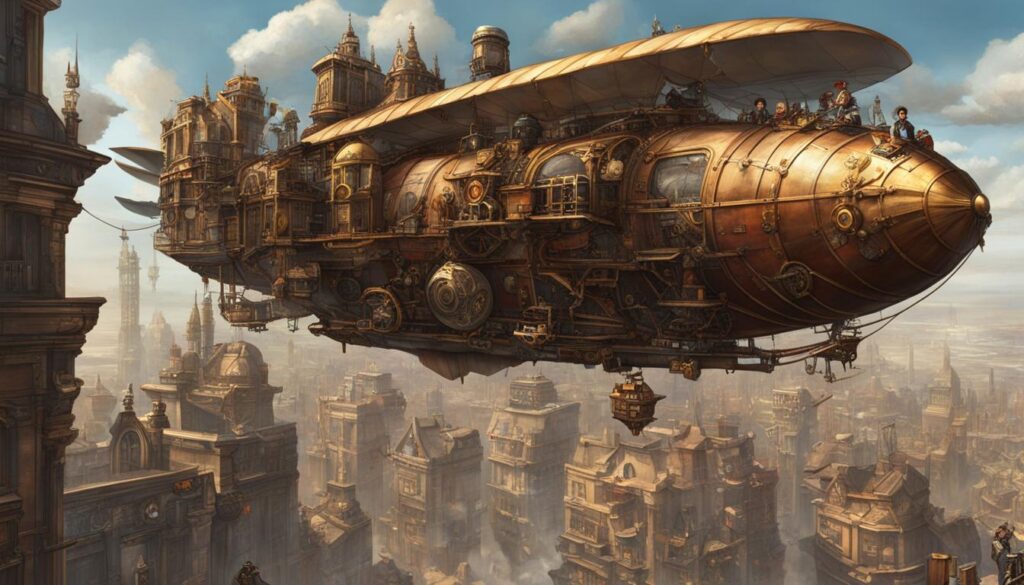
The Table below showcases the key elements that define the relationship between steampunk and postmodernism in literature and film:
| Steampunk | Postmodernism |
|---|---|
| Blurring boundaries between past and present | The absence of a single objective truth |
| Incorporates intertextuality and fragmented narratives | Challenges traditional storytelling conventions |
| Deconstructs history and offers alternate perspectives | Engages in meta-narratives that question reality |
| Reflects on social issues through a retrofuturistic lens | Embraces ambiguity and the multiplicity of realities |
Examining the Philosophical Underpinnings of Steampunk and Postmodernism
Steampunk and postmodernism share a deep connection at the philosophical level. Both challenge traditional notions of truth, reality, and history, providing a thought-provoking exploration of their respective themes. In the case of steampunk, it takes a unique approach to postmodern philosophy, offering a compelling reflection on the relationship between past and present.
One of the defining characteristics of steampunk is its deconstruction of history. Through alternative versions of the past, steampunk tales question established narratives, inviting readers to question the veracity of historical truths. By blurring the boundaries between fact and fiction, steampunk challenges the notion of a single objective truth and embraces the concept that reality is subjective and constructed.
Furthermore, steampunk narratives often blur the boundaries between different genres, such as science fiction, fantasy, and historical fiction. This blending of genres allows for a unique storytelling experience that challenges traditional storytelling conventions. Steampunk’s embrace of multiple realities and possibilities aligns with postmodern philosophy, highlighting the inherent subjectivity and ambiguity of the human experience.
| Steampunk’s Reflection on Past and Present | Postmodern Philosophy |
|---|---|
| Deconstructs history | Challenges established narratives |
| Blurs boundaries between genres | Embraces multiple realities and possibilities |
| Questions historical truths | Rejects the notion of a single objective truth |
“Steampunk’s deconstruction of history challenges the foundations of traditional storytelling, inviting readers to question the veracity of historical narratives and explore alternative perspectives.” – Critic
Steampunk’s infusion of postmodern philosophy offers readers a unique perspective on the relationship between past and present. By deconstructing history, blurring genre boundaries, and questioning established narratives, steampunk provokes thoughtful reflection on the nature of truth, reality, and the construction of knowledge.
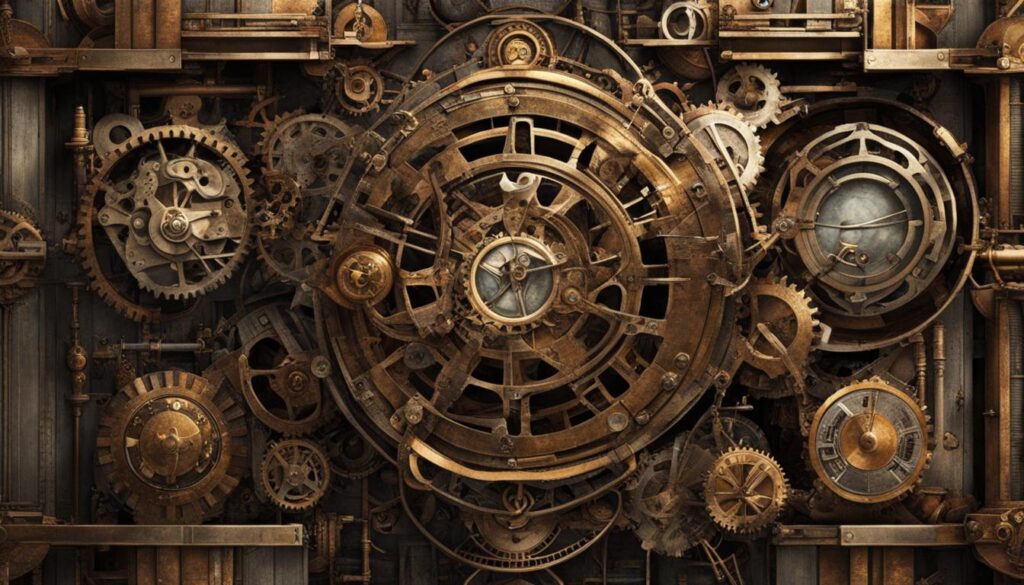
Steampunk’s Take on Postmodern Philosophy
Steampunk challenges traditional notions of truth, reality, and history, aligning itself with postmodern philosophy. It invites readers to explore the complexities of the human experience, embracing ambiguity and the multiplicity of perspectives. Steampunk’s reflection on the past and present serves as a reminder that history is not a fixed entity but rather a malleable construct shaped by storytelling and interpretation.
Conclusion
Steampunk and postmodernism form a fascinating and intricate connection that has left an indelible mark on our cultural landscape. By incorporating postmodern themes, aesthetics, and philosophy, steampunk challenges traditional storytelling conventions and offers alternative versions of the past. It not only reflects on the relationship between the past and the present but also embraces ambiguity and deconstructs historical narratives.
With its unique blend of retrofuturistic technology, Victorian fashion, and alternative history, steampunk has become a cultural movement that influences various aspects of popular culture. The subgenre’s impact can be seen in fashion, art, design, and music. Steampunk-inspired fashion has given rise to its own subculture, while visual and musical artists have incorporated steampunk elements into their work, adding to its allure.
In conclusion, the relationship between steampunk and postmodernism unveils the ever-evolving nature of storytelling and the power of art to reflect and comment on society. Steampunk’s ability to question established norms and beliefs, blur boundaries between past and present, and explore multiple realities or possibilities echoes the essence of postmodern philosophy. It is an intriguing genre that continues to captivate and inspire, shaping the way we perceive and engage with narratives.
FAQ
What is steampunk?
Steampunk is a subgenre of science fiction that combines retrofuturistic technology and aesthetics inspired by 19th-century industrial steam-powered machinery.
When did steampunk emerge?
Steampunk emerged in the 1980s, but it retroactively refers to works created as far back as the 1950s or earlier.
What are the key elements of steampunk?
Steampunk works feature anachronistic technologies, fictional machines, alternative history-style presentations of steam-powered technology, and often incorporate elements from other genres such as fantasy, horror, historical fiction, or alternate history.
How does steampunk explore alternative futures or pasts?
Steampunk explores alternative futures or pasts by presenting an alternative version of the Victorian era or the American Wild West, where steam power remains in mainstream use.
What is the relationship between steampunk and postmodernism?
Steampunk and postmodernism intersect in literature and film, with steampunk novels and films incorporating postmodern elements such as fragmented narratives, self-reflexivity, and intertextuality.
How has steampunk influenced popular culture?
Steampunk has had a significant cultural impact, influencing various aspects of popular culture, including fashion, art, design, and music. Steampunk-inspired fashion has become a subculture of its own, and the aesthetic has been embraced by visual and musical artists.
Is steampunk a postmodern genre?
Yes, steampunk can be considered a postmodern genre due to its reflection on the relationship between past and present, its deconstruction of history, and its embrace of postmodern philosophy.
What are the philosophical underpinnings of steampunk and postmodernism?
Both steampunk and postmodernism challenge traditional notions of truth, reality, and history. They embrace the idea that there is no single objective truth, and they blur boundaries between past and present, fantasy and reality.
Source Links
- https://en.wikipedia.org/wiki/Steampunk
- https://scholar.archive.org/work/qszafq4sd5hkthqrgj6fedzzoy/access/wayback/https://era.library.ualberta.ca/items/af46dcb5-93c2-4562-8328-fc8b06c35d36/view/62128291-a452-4153-940b-51be53df9442/Perschon_Mike_2012.pdf
- http://retromaniabysimonreynolds.blogspot.com/2022/11/sideways-through-time-steampunk.html?m=1


